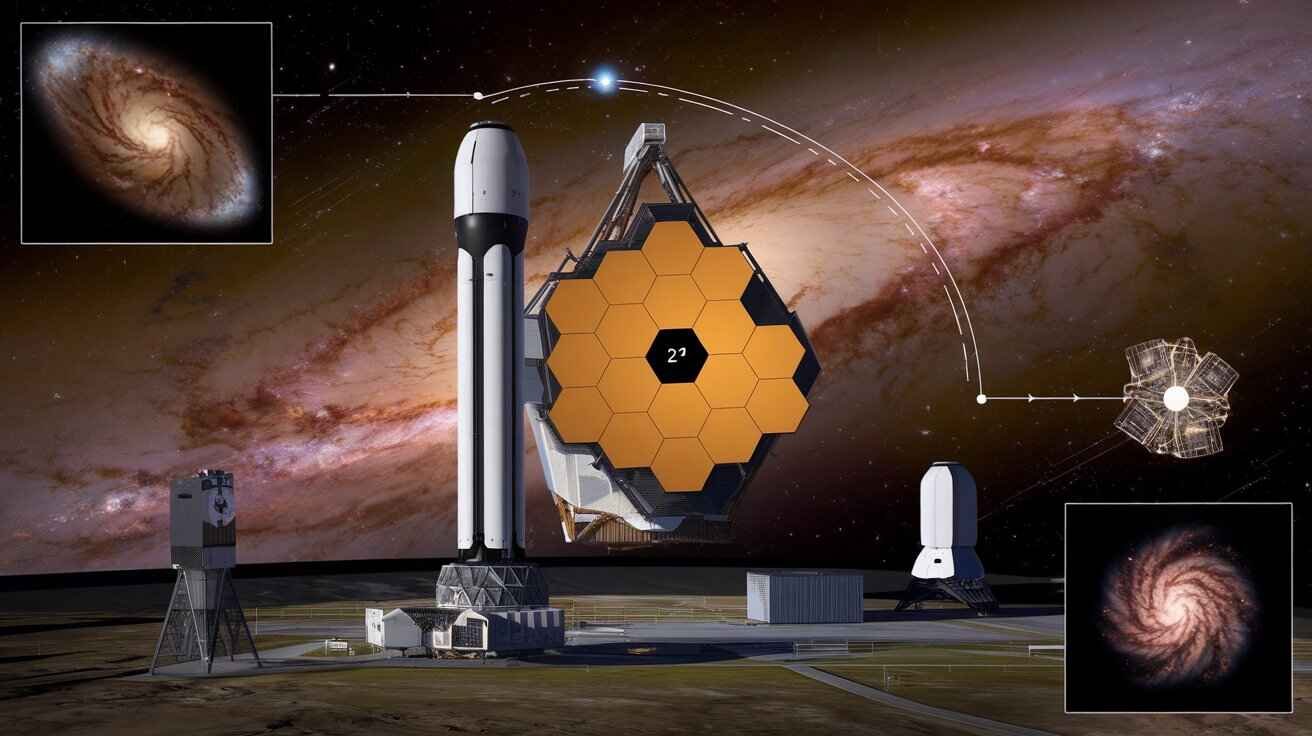The James Webb Space Telescope (JWST) is one of the most ambitious space missions ever conceived. Launched on December 25, 2021, JWST was designed to discover the universe through previously thought-impossible methods. Unlike its predecessors, the Hubble Space Telescope, JWST operates in the infrared spectrum, allowing researchers to see deeper into space and back in time than ever before. With its strategic positioning on the 2nd Lagrange factor (L2), over 1 million kilometres from Earth, JWST’s objectives are to reply to a number of the most profound questions about the origins of the universe, the formation of stars and galaxies, and the capacity for existence beyond Earth.
The Importance of L2: Perfect Position for JWST’s Mission
What is L2, and How Does it Benefit JWST?
The 2nd Lagrange factor (L2) is a gravitationally solid spot in space where the gravitational pull of the Earth and the Sun balance out. This function permits JWST to remain in a stable orbit, a long way far enough from the heat and interference of Earth, while still preserving line-of-sight verbal exchange with venture manipulation. The strategic placement of JWST at L2 ensures that the telescope remains at the effective temperature, which is important for its infrared contraptions.
- Thermal Protection: JWST’s sunshield affords protection from the Sun’s heat, permitting its instruments to keep temperatures below 50K (-223°C), which is important for infrared observations.
- Uninterrupted Views: Being located at L2 guarantees that the telescope can observe the cosmos without interference from Earth or the Moon, permitting nonstop and uninterrupted observations.
This orbit allows JWST to focus on deep-area imaging, spectral evaluation of exoplanet atmospheres, and photo-taking of distant galaxies and stars formed quickly after the Big Bang.
Course Correction: The Key to Precision
After JWST was released on December 25, 2021, aboard an Ariane 5 rocket, it embarked on a journey to reach L2. However, the trajectory changed into a non-straight line, and slight modifications were necessary to ensure the spacecraft arrived correctly at its destination.
The First Course Correction: Ensuring Proper Trajectory
Approximately 12 hours after launch, the primary mid-direction correction (MCC) was carried out. This manoeuvre involved firing small thrusters to adjust the spacecraft’s trajectory. The aim was to set JWST on the right route to L2, ensuring it would not deviate due to preliminary release inaccuracies or gravitational forces.
This first MCC was crucial as it helped refine the trajectory, minimizing the need for extra corrections. The adjustment ensured that JWST may want to successfully keep its journey even as holding gasoline.
Second MCC: Fine-Tuning for Precision
A few days after launch, NASA engineers performed the second MCC. This excellent-tuning manoeuvre similarly corrected JWST’s course, bringing it toward the right orbit around L2. The spacecraft’s trajectory required regular monitoring, and NASA’s Deep Space Network (DSN) played a key role in presenting actual-time data and ensuring the spacecraft’s position was accurately tracked.
Final Adjustment: A Smooth Entry to L2
Upon nearing L2, JWST underwent its last path correction to place itself perfectly within its operational orbit. This adjustment ensured that the spacecraft reached its very last destination with the accuracy required for its medical undertaking. NASA engineers carefully calculated to ensure that the adjustment turned into minimum but highly powerful, permitting the telescope to arrive at L2 without overshooting or wasting gasoline.
Also Checkout: NVDA 17K: NVIDIA’s Path to Dominance in AI, Gaming, and Cloud Computing
Station-Keeping: Maintaining JWST’s Position at L2
Once JWST arrived at its orbit, preserving its position became crucial. This procedure is referred to as station-preserving, and it involves minor direction corrections made periodically to ensure that JWST remains in its safest orbit.
- Gravity Influences: While L2 is solid, diffused gravitational forces from the Sun, Earth, and the Moon can cause small modifications inside the spacecraft’s orbit. These forces require periodic changes to hold JWST in the perfect area for its observations.
- Use of Ion Thrusters: To make those changes, JWST relies on ion thrusters, which provide small, unique manoeuvres that permit it to keep its role without using too much fuel. These thrusters are efficient and effective, extending the project’s lifetime by protecting gas.

Technological Innovations That Support JWST’s Success
JWST’s capability to carry out those critical path corrections and preserve its orbit is powered through modern technology and revolutionary structures designed for the challenge:
- Autonomous Navigation and Precision Thrusters
- JWST is equipped with advanced celebrity trackers and gyroscopes that permit it to navigate autonomously, making changes without consistent input from Earth.
- The spacecraft’s reaction wheels help it high-quality-song its orientation, ensuring its contraptions stay aligned at some observation stage.
- Massive Sunshield Deployment
- One of JWST’s most outstanding capabilities is its 5-layer sunshield, which is ready for the scale of a tennis court. This sun-shield change deployed efficiently during the early levels of the assignment and protects its sensitive units from the Sun’s warmth, permitting the telescope to perform at temperatures below 50K (-223°C).
- Advanced Mirror Technology
- JWST’s segmented primary replicate, which is 6.5 meters in diameter, is made up of 18 hexagonal gold-coated segments. These mirrors were exactly aligned post-release to ensure clean, sharp photos of distant objects in the infrared spectrum.
Key Discoveries and the Future of JWST
Since its deployment, JWST has started sending again stunning photographs and information that promise to reshape our expertise of the universe. Some of the most exciting discoveries encompass:
The Deepest Images of the Universe
In July 2022, JWST released its first photographs of the innermost parts of the universe. These high-decision images show galaxies formed over 13 billion years ago, supplying treasured insights into the early degrees of the universe. These pictures are far clearer and more unique than any snapshots formerly captured by Hubble.
- Deep Field Imaging: JWST’s ability to capture deep-field photos has revealed galaxies and stars formed just a few hundred million years after the Big Bang. This marks a major advancement in our capability to examine the early universe.
Exoplanet Exploration: A New Frontier
JWST has the potential to examine the atmospheres of exoplanets in detail. Using its infrared contraptions, JWST can detect the composition of exoplanet atmospheres, looking for symptoms of water, carbon dioxide, or even methane that could hint at the possibility of existence.
- Atmospheric Studies: These studies are essential for knowledge of the conditions on distant planets and determining if they might help existence. This is a place where JWST should profoundly impact our expertise of habitability within the universe.

The Evolution of Stars and Galaxies
JWST is likewise assisting astronomers look at the delivery and evolution of stars and galaxies. By gazing at distant star-forming areas, JWST can provide insights into the approaches that result in the formation of stars and planetary systems.
JWST’s Future: Continuous Exploration and Maintenance
As JWST keeps orbiting L2 and ships lower back helpful records, NASA and its global companions continue to focus on its long-term assignment.
- Ongoing Mission Updates: JWST will keep current records on the universe’s evolution, exoplanet atmospheres, and the start of stars and galaxies.
- Regular Updates and Maintenance: Engineers will perform normal checks of the spacecraft’s systems and perform any important software updates or hardware protection to preserve the telescope in top operational condition.
Conclusion: A New Era in Space Exploration
The James Webb Space Telescope represents a new chapter in exploring the universe. With its extraordinary technological abilities, precision direction corrections, and effective infrared observations, JWST is poised to reply to some of the most pressing questions in the cosmos. As it makes discoveries, it’ll provide humanity with a deeper knowledge of the universe and its origins, paving the way for future space missions.
FAQs
What is the James Webb Space Telescope’s most important project?
JWST’s major challenge is to examine the universe in the infrared spectrum, focusing on deep-area exploration, exoplanets, and big-name formation.
Why is JWST located at L2?
L2 is an excellent role for JWST because it provides solid, uninterrupted views of the universe and protects the telescope from the Sun’s warmth.
How does JWST stay on course during its adventure?
JWST uses path corrections and ion thrusters to maintain its trajectory and live in its precise orbit at L2.
What makes JWST’s technology so advanced?
JWST’s advanced generation consists of infrared contraptions, a large sun shield, and a fantastically touchy replica device that allows it to capture unprecedented photos of distant galaxies and stars.
How lengthy is JWST predicted to perform?
JWST is designed to perform for at least 10 years, with the ability to sustain a prolonged project relying on gasoline utilization and machine toughness.
Also Read: X Launched Stories: Instant News Summaries with Grok AI





